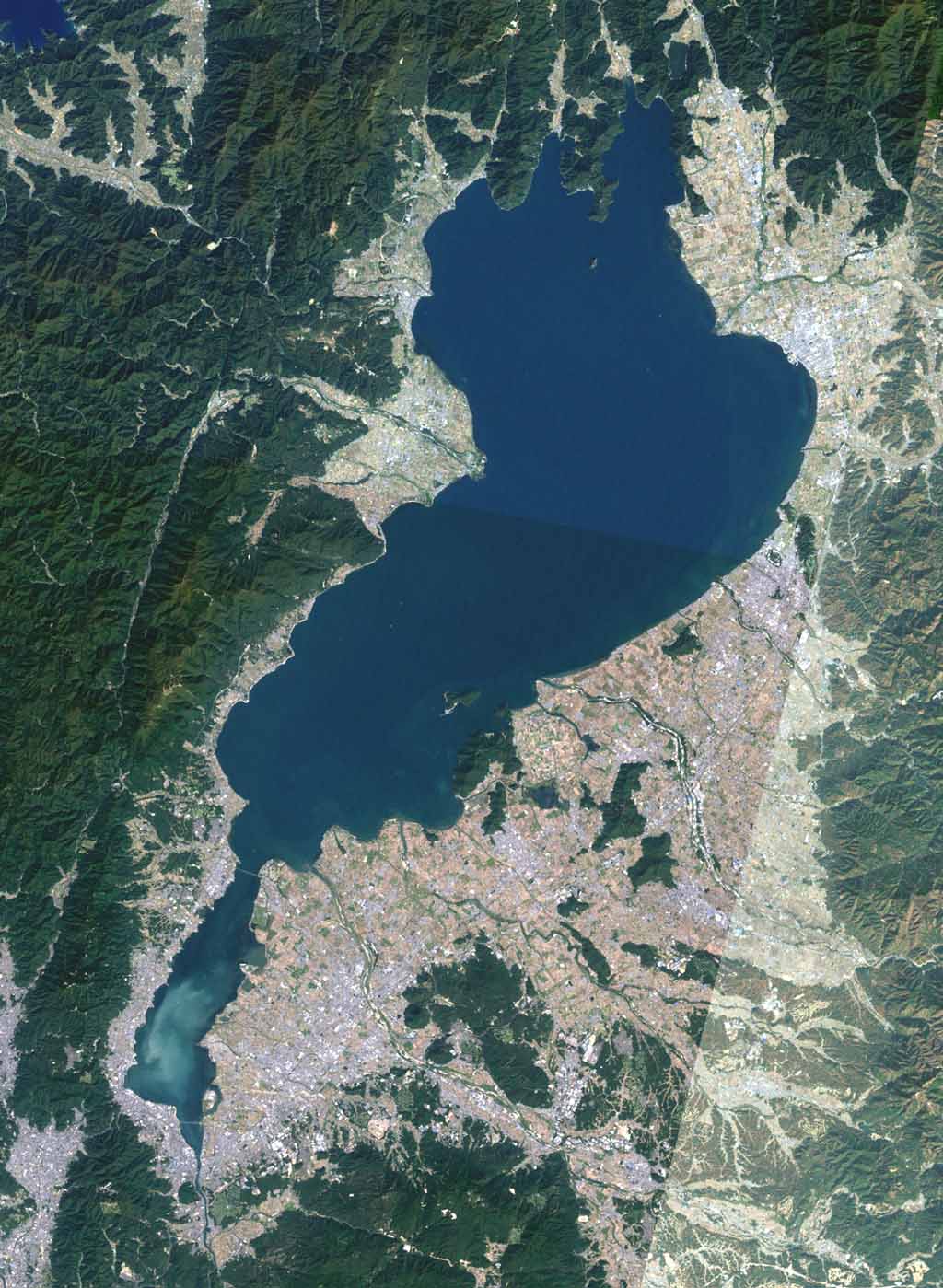|
Shin-Yōkaichi Station
is a passenger railway station in located in the city of Higashiōmi, Shiga Prefecture, Japan, operated by the private railway operator Ohmi Railway. Lines Shin-Yōkaichi Station is served by the Ohmi Railway Yōkaichi Line, and is located 0.7 rail kilometers from the terminus of the line at Yōkaichi Station. Station layout The station consists of two unnumbered side platform A side platform (also known as a marginal platform or a single-face platform) is a platform positioned to the side of one or more railway tracks or guideways at a railway station, tram stop, or transitway. A station having dual side platforms, ...s connected to the station building by a level crossing. The station is unattended. Platforms Adjacent stations History Shin-Yōkaichi Station was opened on December 29, 1913 as . It was renamed to its present name on July 1, 1919. The station building was built in 1922. The second floor of the station building was once used as the head offic ... [...More Info...] [...Related Items...] OR: [Wikipedia] [Google] [Baidu] |
Ohmi Railway
is a Japanese private railway company which operates in Shiga Prefecture, and a member of the Seibu group since 1943. The company is named after the Ōmi Province, the former name of the present-day Shiga. The railway is nicknamed by local users because of its noisy sound. History Ohmi Railway is the longest private railway company in Shiga. The company was founded in 1896 and started train services from Hikone to Echigawa in 1898. The company was a subsidiary of from 1926 to 1942. In 1944, the company absorbed the , now the Yokaichi Line. Lines Ohmi Railway consists of three lines: the Main Line, and two branch lines, the Yōkaichi Line and the Taga Line. The Main Line connects with the Tōkaidō Main Line (Biwako Line), the Hokuriku Main Line and the Tōkaidō Shinkansen at Maibara, the Biwako Line at Hikone, and the Kusatsu Line and the Shigaraki Kōgen Railway at Kibukawa. The Yōkaichi Line connects with the Biwako Line at Ōmi-Hachiman. At first, the Main Line was ... [...More Info...] [...Related Items...] OR: [Wikipedia] [Google] [Baidu] |
Ohmi Railway Yōkaichi Line
The is a regional railway line in Shiga Prefecture operated by Ohmi Railway. The line is 9.3 km long, connecting Yōkaichi on the Main Line in Higashiōmi to Ōmi-Hachiman on the JR West Biwako Line in Omihachiman. In addition to local shuttle trains, the Yōkaichi Line trains include Rapid Service that connects Yōkaichi and Ōmi-Hachiman nonstop, and through trains to the Main Line to Maibara or Kibukawa. History The Hunan Railway Co. opened the line in 1913, and merged with the Ohmi Railway Co. in 1944. The line was electrified at 1,500 VDC in 1946. Former connecting lines * Shin-Yōkaichi station - A 3km line to the Misono airfield operated between 1930 and 1948. Stations :Rapid Service: + = stop; - = pass; :Local trains make all stops See also * List of railway lines in Japan List of railway lines in Japan lists existing Rail transport, railway lines in Japan alphabetically. The vast majority of Japanese railways are classified under two Japanese laws, on ... [...More Info...] [...Related Items...] OR: [Wikipedia] [Google] [Baidu] |
Railway Station
Rail transport (also known as train transport) is a means of transport using wheeled vehicles running in railway track, tracks, which usually consist of two parallel steel railway track, rails. Rail transport is one of the two primary means of land transport, next to road transport. It is used for about 8% of passenger and rail freight transport, freight transport globally, thanks to its Energy efficiency in transport, energy efficiency and potentially high-speed rail, high speed.Rolling stock on rails generally encounters lower friction, frictional resistance than rubber-tyred road vehicles, allowing rail cars to be coupled into longer trains. Power is usually provided by Diesel locomotive, diesel or Electric locomotive, electric locomotives. While railway transport is capital intensity, capital-intensive and less flexible than road transport, it can carry heavy loads of passengers and cargo with greater energy efficiency and safety. Precursors of railways driven by human or an ... [...More Info...] [...Related Items...] OR: [Wikipedia] [Google] [Baidu] |
Shiga Prefecture
is a landlocked prefecture of Japan in the Kansai region of Honshu. Shiga Prefecture has a population of 1,398,972 as of 1 February 2025 and has a geographic area of . Shiga Prefecture borders Fukui Prefecture to the north, Gifu Prefecture to the northeast, Mie Prefecture to the southeast, and Kyoto Prefecture to the west. Ōtsu is the capital and largest city of Shiga Prefecture, with other major cities including Kusatsu, Nagahama, and Higashiōmi. Shiga Prefecture encircles Lake Biwa, the largest freshwater lake in Japan, and 37% of the total land area is designated as Natural Parks, the highest of any prefecture. Shiga Prefecture's southern half is located adjacent to the former capital city of Kyoto and forms part of Greater Kyoto, the fourth-largest metropolitan area in Japan. Shiga Prefecture is home to Ōmi beef, the Eight Views of Ōmi, and Hikone Castle, one of four national treasure castles in Japan. History Shiga was known as Ōmi Province or Gōshū bef ... [...More Info...] [...Related Items...] OR: [Wikipedia] [Google] [Baidu] |
Yōkaichi Station
is a passenger junction railway station located in the city of Higashiōmi, Shiga Prefecture, Japan. It is the main station in Higashiōmi city and one of the most important stations of Ohmi railway. Lines Yōkaichi Station is served by the Ohmi Railway Main Line (Koto Ohmi Line, Minakuchi Gamono Line), and is located 25.3 rail kilometers from the terminus of the line at Maibara Station. It is also a terminus of the Yōkaichi Line (Man-yō Akane Line) and is 9.3 kilometers from the opposing terminus of that line at Ōmi-Hachiman Station. Station layout The station consists of an island platform and a side platforms connected to the station building by a footbridge. Platforms Adjacent stations History Yōkaichi Station was opened on July 24, 1898. The station building was reconstructed in 1998. A museum was opened don the second floor of the station building in 2019. Passenger statistics In fiscal 2019, the station was used by an average of 2161 passengers dail ... [...More Info...] [...Related Items...] OR: [Wikipedia] [Google] [Baidu] |
Side Platform
A side platform (also known as a marginal platform or a single-face platform) is a platform positioned to the side of one or more railway tracks or guideways at a railway station, tram stop, or transitway. A station having dual side platforms, one for each direction of travel, is the basic design used for double-track railway lines (as opposed to, for instance, the island platform where a single platform lies between the tracks). Side platforms may result in a wider overall footprint for the station compared with an island platform, where a single width of platform can be shared by riders using either track. In some stations, the two side platforms are connected by a footbridge or tunnel to allow safe access to the alternate platform. While a pair of side platforms is often provided on a dual-track line, a single side platform is usually sufficient (trains are usually only boarded from one side) for a single-track line. Layout Where the station is close to a level crossing (g ... [...More Info...] [...Related Items...] OR: [Wikipedia] [Google] [Baidu] |
Japan National Route 421
National Route 421 is a national highway of Japan connecting Kuwana, Mie is a Cities of Japan, city located in Mie Prefecture, Japan. , the city had an estimated population of 141,045 in 60,301 households and a population density of 1000 persons per km2. The total area of the city is . Geography Kuwana is located in ... and Ōmihachiman, Shiga in Japan, with a total length of 72 km (44.74 mi). References National highways of Japan Roads in Mie Prefecture Roads in Shiga Prefecture 1982 establishments in Japan {{Japan-road-stub ... [...More Info...] [...Related Items...] OR: [Wikipedia] [Google] [Baidu] |
Railway Stations In Japan Opened In 1913
Rail transport (also known as train transport) is a means of transport using wheeled vehicles running in tracks, which usually consist of two parallel steel rails. Rail transport is one of the two primary means of land transport, next to road transport. It is used for about 8% of passenger and freight transport globally, thanks to its energy efficiency and potentially high speed.Rolling stock on rails generally encounters lower frictional resistance than rubber-tyred road vehicles, allowing rail cars to be coupled into longer trains. Power is usually provided by diesel or electric locomotives. While railway transport is capital-intensive and less flexible than road transport, it can carry heavy loads of passengers and cargo with greater energy efficiency and safety. Precursors of railways driven by human or animal power have existed since antiquity, but modern rail transport began with the invention of the steam locomotive in the United Kingdom at the beginning of the 19th ... [...More Info...] [...Related Items...] OR: [Wikipedia] [Google] [Baidu] |




